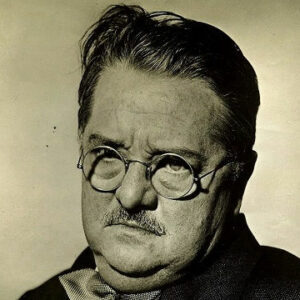Alexander Humphreys Woollcott was a reviewer and commentator for the magazine “The New Yorker” in the United States. He was also a member of the illustrious Algonquin Round Table of writers, critics, and actors. He began his work as a bank clerk before joining “The New York Times” as a reporter. During World War I, his bad eyesight and physique prevented him from joining the military. His use of biting wit as a prominent New York theatrical critic used to entice or repel the cultural groups of 1920s Manhattan. He was also barred from reviewing some Broadway shows for a short time. He used to write for a number of publications, including “Reader’s Digest.” He was chastised for his use of an extravagant and florid writing style. Despite this, Woollcott’s novel “While Rome Burns” was named one of the fifty-two “greatest loved works of the twentieth century” by critic Vincent Starrett. He also had a good radio career. He made multiple broadcasts in England at the BBC’s request during World War II. Woollcott was also the inspiration for the main character in George S. Kaufman and Moss Hart’s play “The Man Who Came to Dinner.”
Childhood and Adolescence
Alexander Woollcott was born in the New Jersey town of Phalanx. His early years were spent in poverty. He read practically all of Charles Dickens’ literary creations as a child because he was a voracious reader.
He attended Central High School in Kansas City, Missouri, throughout his time there. Woollcott was the editor of the student journal and started a theatre group as a student.
Career of Alexander Woollcott
Before joining “The New York Times” as a reporter in 1909, he worked as a bank clerk and other positions. He was able to catch the editor’s notice here, Carr Van Anda.
He covered the sinking of the Titanic as a reporter before pursuing his love and vocation as a theatre critic. He worked at this publication till 1922.
He served in the United States army during WWI, first as an orderly and then as a sergeant. The intelligence branch of the American Expeditionary Forces recruited him and a group of newspaper men to develop an official newspaper to boost military morale.
He reported on the tragedies of the Great War from the perspective of a typical soldier as a correspondent for “Stars and Stripes.” He returned to “The New York Times” after the war.
He worked for “The New York Herald” in 1922. He joined “The World” the next year and remained there until 1928. He wrote a column for “The New Yorker” called “Shouts and Murmurs” from 1929 until 1934.
In October 1929, he began his radio career with “The Early Bookworm,” a book review program on CBS Radio. The program was extended until 1933. In the same year, he launched “The Town Crier,” a radio program that lasted until 1938.
Woollcott also belonged to the Algonquin Round Table, a well-known collection of critics, playwrights, wits, and actors. Along with playwright George S. Kaufman, he co-wrote two Broadway plays.
He indicated his willingness to serve in the Second World War when it began, but he was unable to do so due to his bad health. He was in England at the time, making multiple radio programs and touring the war-damaged cities and towns.
Aside from that, he also dabbled in acting. He made cameo appearances in various films in the late 1930s and early 1940s. He made his stage debut in the traveling production of ‘The Man Who Came to Dinner,’ a three-act comedy, in 1940.
His final radio program, “The People’s Platform,” was broadcast on CBS Radio in 1943. He finished editing his book “As You Were” just before his death. It’s a collection of fiction, poetry, and nonfiction for military personnel.
Personal History and Legacy
When he was in his early twenties, he contracted mumps. He was somewhat impotent as a result of this illness. He lived his entire life as a bachelor. He did, however, have a number of female friends, including Dorothy Parker and Neysa McMein, who merit special note.
During a radio program, he had a heart attack. He died at the age of 56 at New York’s Roosevelt Hospital after a few hours due to a brain hemorrhage.
Estimated Net Worth
Alexander is one of the wealthiest journalists and one of the most well-known. Alexander Woollcott’s net worth is estimated to be $1.5 million, according to Wikipedia, Forbes, and Business Insider.
Trivia
This well-known figure was born in a dilapidated building with 85 rooms. Known as The Phalanx, this structure was the site of a number of social experiments in the 1880s.
A number of well-known actors took on the role of this multi-talented personality. This significant figure was played by actors Earl Montgomery in the film ‘Act One,’ Jock Livingston in ‘Star!,’ and Tom McGowan in ‘Mrs. Parker and the Vicious Circle.’


